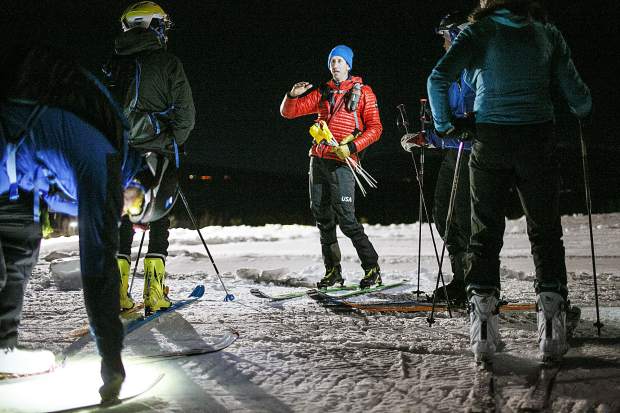
Events are similar to local mountain bike race or fun run. Once the start gun goes off, the race spreads out and everyone goes their own pace. There’s nobody in the woods or on the mountain early in morning to see how slow (or fast) you’re going – so don’t worry about “how I’ll do”. Just look forward to powder skiing and getting in some good exercise.
Make a day out of it. Most events include a lift ticket (or give you a discounted ticket option), so bring the family and friends and ski after. The raffle is usually the highlight – so stick around to win something. And many a great next-day backcountry tour has been planned with beer in hand waiting for the raffle/awards.
Mandatory gear: helmet (bike helmet ok), avalanche beacon, shovel, probe, small pack with ski loops, skins. Note that not all events require any or all of the above, but it’s best to bring the gear to the event. (And you’re set to ski after the race.)
Pick a category: If it’s your first race and you’re unsure of your fitness and/or your gear, enter the Rec category; average vertical is 2,000 – 2,500 feet with two uphills and three transitions. The average participant will be out between 1:20 and 2.5 hours.
If you’ve been skiing and skinning often and would like a longer race, enter the Heavy Metal Race or Race Category: 4,000 – 5,500 vertical. If you have lighter gear and want to race against faster people, the Race Category is for you. The winner will finish between 1.5 – 2 hours, the average participant 2.5 – 3.5 hrs.
The course: Most events are based around ski areas, there will be some skinning and skiing on groomed runs. But whenever possible, the skiing is on un-groomed expert runs and the skinning on more interesting/remote areas of the mountain.
The race: Keep your warm clothes on until just before the start – there’ll be a pile of clothes to the side of the start line. All categories start together. LeMans-style start events have all racers put their skis behind the starting line, then line up 50 ft. behind their skis. At the start, racers jog to their skis, clip in their bindings then start skinning.
Racers start with skins on their skis. The route is marked with pin-flags, orange disks, ribbons and arrows. Follow the flags (the first ascent may be on a wide, groomed run), to the first transition. This will be well-marked and usually have a course marshal. Remove your skins and follow markings down to the next transition. Put your skins back on and repeat.
It is the responsibility of the racer to know the course and follow the markings. Course maps are posted on the USSMA and/or event website prior to the event.
What to wear: Most people over-dress for their first event – you’ll generate a lot of heat going up and cool off on the downhills. Dress for a day of cold cross-country skiing or spring back-country skiing. A 3/4 or full-zip jersey outer layer is important – you’ll stuff your skins in your jersey front for the downhills. A medium-weight glove with Windstopper works well.
Equipment: Any ski-skin or board-skin combo will work – you’ll see every imaginable combination of backcountry gear at a race. If you have lighter backcountry skis, you’ll go up faster with lighter gear. If you have fatter skis, the Heavy Metal category is the largest and most popular. Telemark or AT makes no difference in your category. People in the Race category will often use a cross-country type pole as it’s lighter.
Courses with steep boot-backs will require racers to put their skis on a pack (this is for safety: giving you free hands and not dropping skis on those below you). If it’s icy or difficult, there will a rope for racers to help guide them up.
Drink and food: Wear an insulated hydration pack w/ lined tube filled with a waterbottle-portion of warm energy drink. (Water is very heavy – don’t fill your reservoir, you won’t drink much when it’s cold). Put two energy shots in your jersey for the last hour of your race.
Some events are supported with food and drink – but be sure and ask at registration.
